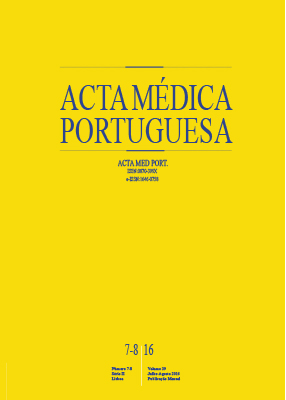Main Causes of Occupational Allergic Contact Dermatitis: A Three Year Study in the Center of Portugal
DOI:
https://doi.org/10.20344/amp.6605Keywords:
Allergens, Dermatitis, Allergic Contact/etiology, Occupational/etiology, Methacrylates, Patch Tests, Portugal.Abstract
Introduction: Allergic contact dermatitis, along with irritant contact dermatitis and immediate contact reactions, contact urticarial, are the most frequent dermatological occupational disease, but seldom reported to the National authorities.Material and Methods: We performed a 3-year retrospective study at the allergology section in the Dermatology Clinic of the University Hospital of Coimbra to evaluate the main occupations diagnosed as occupational allergic contact dermatitis, most common allergens and the effect of the modification of the work station in the evolution of the disease.
Results: During 2012 - 2014 among the 941 patch tested patients, 77 (8.2%) were diagnosed with occupational allergic contact dermatitis, with 169 positive patch tests related to occupational exposure, 55 detected within the baseline and 114 in complementary test series. In most cases allergic contact dermatitis involved the hands (88.3%), main professional activities were nail estheticians and hairdressers due to the manipulation of (meth)acrylates, the most common allergen in the study. After the diagnosis, 27.3% abandoned
the work, 23.4% changed the work station, 49% avoided exposure to the responsible allergen. Contact dermatitis resolved in 39% of the patients, improved in 39% but had no change in the remaining 22%.
Discussion: This study, although including only patients from the center of Portugal, evaluates a large sample of patients with different occupations studied with a larger variety of allergens. Apart from classical allergens and professions responsible for occupational allergic contact dermatitis that we found in lower numbers (thiuram mix, paraphenylenodiamine, chromium and cobalt in health care workers, hairdressers and in the building industry), (meth)acrylates tested outside the European and Portuguese Baseline Series were the main cause of occupational allergic contact dermatitis, namely in nail estheticians. Methylisothiazolinone, the second more frequent
occupational contact allergen in the present study was identified in different occupations as a result of the widespread use of this preservative that is causing a real ‘epidemics’ of allergic contact dermatitis all over Europe in the last years.
Conclusion: Nail estheticians are not usually referred as an occupation with a high risk of developing allergic contact dermatitis. Nevertheless, the current fashion combined with professionals poorly informed about the risk of their activity and the high sensitizing potential of (meth)acrylates, leads to a higher frequency of allergic contact dermatitis in recent years.
Downloads
Downloads
Published
How to Cite
Issue
Section
License
All the articles published in the AMP are open access and comply with the requirements of funding agencies or academic institutions. The AMP is governed by the terms of the Creative Commons ‘Attribution – Non-Commercial Use - (CC-BY-NC)’ license, regarding the use by third parties.
It is the author’s responsibility to obtain approval for the reproduction of figures, tables, etc. from other publications.
Upon acceptance of an article for publication, the authors will be asked to complete the ICMJE “Copyright Liability and Copyright Sharing Statement “(http://www.actamedicaportuguesa.com/info/AMP-NormasPublicacao.pdf) and the “Declaration of Potential Conflicts of Interest” (http:// www.icmje.org/conflicts-of-interest). An e-mail will be sent to the corresponding author to acknowledge receipt of the manuscript.
After publication, the authors are authorised to make their articles available in repositories of their institutions of origin, as long as they always mention where they were published and according to the Creative Commons license.









